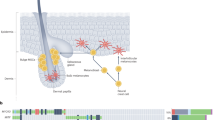Abstract
Novel cell lines, designated NM78-AM and NM78-MM, have been established from a malignant melanoma of the cheek oral mucosa. NM78-AM cells were spherical, grew in suspension as clusters, and produced no melanin. In contrast, NM78-MM cells were adherent and produced melanin granules. Initially, NM78-AM cells were grown on fibroblast feeder cells or in growth media supplemented with 10% conditioned medium from fibroblasts, but eventually grew in standard growth media alone. NM78-AM cells had interdigitating microvilli and formed cell clusters. They had large nucleoli, desmosomes, lipid droplets, and well-developed Golgi apparatuses. In contrast, NM78-MM cells grew as adherent neuron-like cells. They had large prominent nucleoli, irregular nuclear membranes, a number of mitochondria, well-developed Golgi apparatuses, melanosomes at various stages of development in the cytoplasm, and the cells secreted melanin granules. Projections from these melanotic cells formed anastomoses with each other. NM78-MM cells stained immunofluorescently for internexin, neuron specific enolase, NF-200, and glial fibrillary acidic protein. These cells were severely aneuploid, approximating to triploidy, and had many marker chromosomes. We used a real-time monitoring system to evaluate oxygen concentrations in culture medium to investigate the susceptibility of both cell lines to various anti-cancer drugs. NM78-AM cells were slightly sensitive to actinomycin D, but not to cisplatin, irinotecan, the irinotecan metabolite SN-38, taxol, taxotere, bleomycin and methotrexate; NM78-MM cells were sensitive to cisplatin, and not to taxol, taxotere, carboplatin, and irinotecan. These new cell lines, NM78-AM and NM78-MM, will be very important for the development of new chemotherapeutics for oral malignant melanoma.
Similar content being viewed by others
References
Pilskin ME. Malignant melanoma of the oral cavity. In: Clark WH Jr, Golman LI, Mastrangelo MJ, eds. Human Malignant Melanoma. New York: Grune and Stratton, 1979; 125–37.
Moore ES, Martin H. Melanoma of the upper respiratory tract and oral cavity. Cancer 1955; 8: 1167–76.
Ostman J, Anneroth G, Gustafsson H, Tavelin B. Malignant oral tumors in Sweden 196–1989 — an epidemiological study. Oral Oncol 1995; 31B: 106–12.
Tanaka N, Amagasa T, Iwaki H et al. Oral malignant melanoma in Japan. Oral Surg Oral Med Oral Pathol 1994; 78: 81–90.
Nozawa S, Ohta H, Tsukazaki K et al. A newly established melanoma cell line (GAK) with 5-S-cysteinyldopa phenotype. Nippon Sanka Hujinka Gakkai Zasshi 1984; 36: 883–92.
Enjoji M, Nakashima M, Sasaki H et al. Establishment of a melanoma cell line with metastatic characteristics. Human Cell 1995; 8: 115–20.
Sonobe H, Manabe Y, Furihata M et al. Establishment and characterization of a human cell line, HS-MM, derived from a case of clear cell sarcoma. Hum Cell 1990; 3: 352–6.
Takenouchi T. Establishment and characterization of clear cell sarcoma (malignant melanoma of soft parts) cell line. Niigata Igakkai Zasshi 1993; 107: 533–40.
Mizutani N, Kinoshita Y, Mizumura H et al. The establishment and characteristics of a cell line (SSM-1) derived from primary malignant melanoma of the hard palates. Nippon Kouku Geka Gakkaishi 1996; 42: 51–5.
Tagawa T, Yatani R, Nishioka H et al. Primary malignant melanoma of the oral cavity. Case report and establishment of melanoma cell line. Int J Oral Surg 1981; 10: 16–20.
Luyten GPM, Naus NC, Mooy CM et al. Establishment and characterization of primary and metastatic uveal melanoma cell lines. Int J Cancer 1996; 66: 380–7.
Diebold Y, Blanco G, Saornil MA et al. Morphologic and immunocytochemical characterization of four human uveal cell line (melanoma- and melanocytes-derived). Curr Eye Res 1997; 16: 487–795.
Kiguchi K, Ishiwata I, Ishiwata C et al. Establishment and characterization of melanoma cell line derived from malignant melanoma of human uterine cervix. Hum Cell 1998; 11: 93–100.
Maeshima S, Yamada T, Kiyikane K, Mori H. Establishment and characterization of a cell line (DEOC-1) originated from a human malignant melanoma of the skin. Hum Cell 2007; 20: 23–38.
Yamashita S, Takahashi N, Hashimoto H et al. Establishment and characterization of a cell line (IGSK-3) secreting human chorionic gonadotropin, adrenocorticotropic hormone and parathyroid hormone-related protein derived from primary poorly differentiated adenocarcinoma of the stomach. Hum Cell 2008; 21: 88–94.
Amano Y, Okumura C, Yoshida M et al. Measuring respiration of cultured cell with oxygen electrode as a metabolic indicator for drug screening. Hum Cell 1999; 12: 3–10.
Uesu K, Ishikawa H. Analysis of susceptibility test of anti-cancer drugs using new types of oxygen electrodes. Bull Edu Res Nihon Univ Sch Dent Matsudo 2002; 1: 102–15.
Uesu K, Ishikawa H. Analysis of an in vitro susceptibility test of anticancer drugs using new types of oxygen electrodes. Bull Edu Res, Nihon Univ Sch Dent Matsudo 2005; 7: 7–21.
Inui M, Tagawa T, Ohse S, Hamaguchi Y, Murata M. The establishment and the characteristics of cell lines derived from hard palate primary or metastatic malignant melanoma. J Jpn Stomatol Soc 1989; 38: 121–30.
Balaban GB, Herlyn M, Clark WH Jr, Nowell PC. Karyo-typic evolution in human malignant melanoma. Cancer Genet Cytogenet 1986; 19: 113–22.
Becher R, Gibos Z, Karakousis C, Sandberg AA. Nonrandom chromosome changes in malignant melanoma. Cancer Res 1983; 43: 5010–16.
Knecht AK, Bronner-Fraser M. Induction of the neural crest: a multigene process. Nat Rev Genet 2002; 3: 453–61.
Hu F, Mah K, Teramura DJ. Electron microscopic and cytochemical observation of theophylline and melanocyte-stimulating hormone effects on melanoma cells in culture. Cancer Res 1982; 42: 2786–91.
Author information
Authors and Affiliations
Corresponding author
Rights and permissions
About this article
Cite this article
Nakahara, T., Tamaki, Y., Tominaga, N. et al. Novel amelanotic and melanotic cell lines NM78-AM and NM78-MM derived from a human oral malignant melanoma. Hum Cell 23, 15–25 (2010). https://doi.org/10.1111/j.1749-0774.2009.00079.x
Received:
Accepted:
Issue Date:
DOI: https://doi.org/10.1111/j.1749-0774.2009.00079.x




